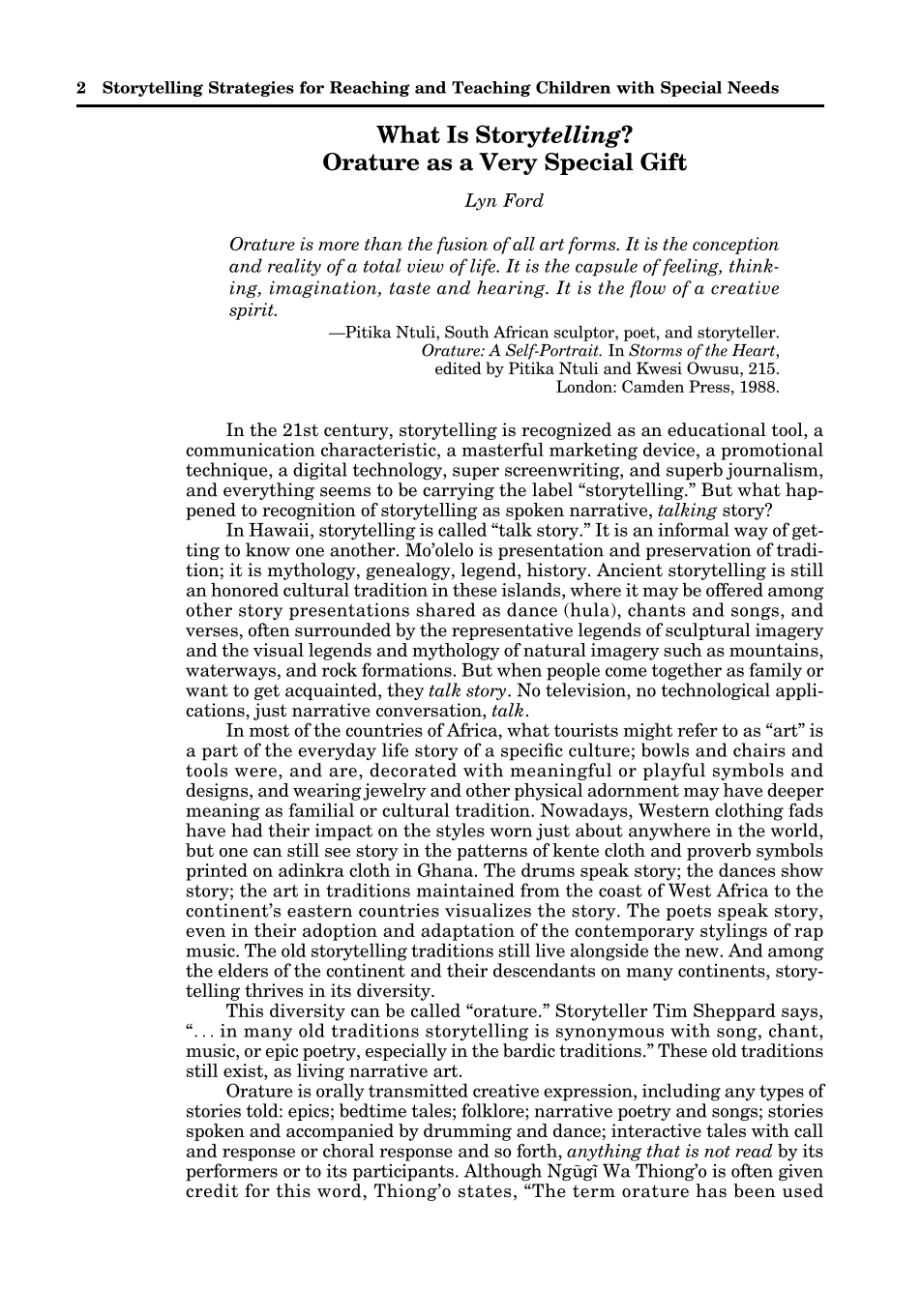What Is Storytelling?
Orature as a Very Special Gift
Lyn Ford
Orature is more than the fusion of all art forms. It is the conception
and reality of a total view of life. It is the capsule of feeling, think-
ing, imagination, taste and hearing. It is the flow of a creative
spirit.
—Pitika Ntuli, South African sculptor, poet, and storyteller.
Orature: A Self-Portrait. In Storms of the Heart,
edited by Pitika Ntuli and Kwesi Owusu, 215.
London: Camden Press, 1988.
In the 21st century, storytelling is recognized as an educational tool, a
communication characteristic, a masterful marketing device, a promotional
technique, a digital technology, super screenwriting, and superb journalism,
and everything seems to be carrying the label “storytelling.” But what hap-
pened to recognition of storytelling as spoken narrative, talking story?
In Hawaii, storytelling is called “talk story.” It is an informal way of get-
ting to know one another. Mo’olelo is presentation and preservation of tradi-
tion; it is mythology, genealogy, legend, history. Ancient storytelling is still
an honored cultural tradition in these islands, where it may be offered among
other story presentations shared as dance (hula), chants and songs, and
verses, often surrounded by the representative legends of sculptural imagery
and the visual legends and mythology of natural imagery such as mountains,
waterways, and rock formations. But when people come together as family or
want to get acquainted, they talk story. No television, no technological appli-
cations, just narrative conversation, talk.
In most of the countries of Africa, what tourists might refer to as “art” is
a part of the everyday life story of a specific culture; bowls and chairs and
tools were, and are, decorated with meaningful or playful symbols and
designs, and wearing jewelry and other physical adornment may have deeper
meaning as familial or cultural tradition. Nowadays, Western clothing fads
have had their impact on the styles worn just about anywhere in the world,
but one can still see story in the patterns of kente cloth and proverb symbols
printed on adinkra cloth in Ghana. The drums speak story; the dances show
story; the art in traditions maintained from the coast of West Africa to the
continent’s eastern countries visualizes the story. The poets speak story,
even in their adoption and adaptation of the contemporary stylings of rap
music. The old storytelling traditions still live alongside the new. And among
the elders of the continent and their descendants on many continents, story-
telling thrives in its diversity.
This diversity can be called “orature.” Storyteller Tim Sheppard says,
“. . . in many old traditions storytelling is synonymous with song, chant,
music, or epic poetry, especially in the bardic traditions.” These old traditions
still exist, as living narrative art.
Orature is orally transmitted creative expression, including any types of
stories told: epics; bedtime tales; folklore; narrative poetry and songs; stories
spoken and accompanied by drumming and dance; interactive tales with call
and response or choral response and so forth, anything that is not read by its
performers or to its participants. Although Ngugı˜ ~ Wa Thiong’o is often given
credit for this word, Thiong’o states, “The term orature has been used
2 Storytelling Strategies for Reaching and Teaching Children with Special Needs

















































































































































































































































